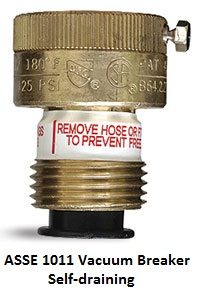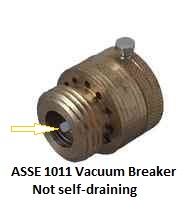Hose Bibb and Garden Hose Usage
Because of their portability and universal ease of connection, general purpose/garden hoses pose one of the greatest risks for back flow occurrences. In addition, there is a general complacency (underestimation of hazard level), with what hoses are connected to or with what they are left submerged in.
In residential applications, the normal way to protect the drinking water system from the hose, and its uses, is to outfit the hose bib (spigot/valve) with a vacuum breaker. Hose bibs are available with integral vacuum breakers or vacuum breakers can be purchased separately and screwed directly onto the outlet threads of the bib. Vacuum breakers are very inexpensive but provide a very good level of protection against backflow.¹

 There are two types of vacuum breakers used for outside faucets, self-draining and not self-draining.
There are two types of vacuum breakers used for outside faucets, self-draining and not self-draining.
For self-draining vacuum breakers, first, turn off water inside of house, second, remove the hose from the faucet, and finally turn off the faucet.
If you don’t have the self-draining vacuum breaker on your faucet, it requires you to drain the water from the vacuum breaker by first turning off the water on the inside of the house, second remove the hose from the faucet, third push the plastic piece in the center to one side to drain the water. Draining the faucet of water before freezing temperatures arrive will keep the water pipe from freezing. Finally turn off the faucet on the outside of the house.
This is what could happen to the water pipe when the vacuum breaker is not drained before freezing weather arrives, causing damage to basement ceiling, walls and flooring. A few seconds of time spent on maintenance is worth the effort.
_________________________
¹ https://www/wsscwater.com/backflow
SITE MAP | DISCLAIMER | ACCESSIBILITY & COMPLIANCE | © City of Neenah. All Rights Reserved. Web Design & Development by Stellar Blue Technologies.
SITE MAP | DISCLAIMER
ACCESSIBILITY & COMPLIANCE | © City of Neenah. All Rights Reserved. Web Design & Development by Stellar Blue Technologies.